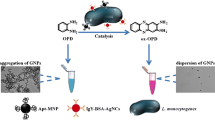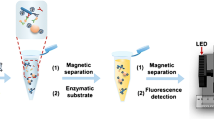Abstract
The aim of this work was to optimize, by means of molecular modeling software, biomimetic-based traps for pathogen detection suitable for analytical applications like screening or pre-analytical methods. The pathogen prototype system chosen was Listeria monocytogenes because of the large number of X ray and NMR structures available. 298 oligopeptides were computationally designed mimicking the binding pocket of the mammalian protein E-cadherin, the target of Listeria monocytogenes adhesion, internalin A. The contribution of individual peptides to bind was investigated using FRED, a protein-ligand docking program. Ten peptides were selected for experimental analysis taking as selection parameters the length, the position in the docking pocket and the score of simulated binding energy. A series of competition assays were carried out using high density colorimetric microarray using various bacteria species (Listeria monocytogenes, Listeria monocytogenes genetically modified without internalin A, Listeria innocua and Lactococcus lactis) in solution with computationally selected peptides. The data demonstrated that peptides could be able to distinguish Listeria monocytogenes with an EC50 up to 107cfu × mL−1. In particular the peptide with the best calculated binding score gave the highest statistically unambiguous response toward Listeria monocytogenes compared to other bacteria, demonstrating that rationally simulated approach can be useful as preliminary screening in the choice of biomimetic ligands.




Similar content being viewed by others
References
Dutta S, Berman HM (2005) Large macromolecular complexes review in the protein data bank: a status report. Structure 13:381
Tozzi C, Anfossi L, Giraudi G (2003) Affinity chromatography techniques based on the immobilisation of peptides exhibiting specific binding activity. J Chromatogr B 797:289
Mascini M, Del Carlo M, Cozzani I, Tiscar PG, Mpamhanga CP, Chen B, Compagnone D (2006) Piezoelectric sensors based on biomimetic peptides for the detection of heat shock proteins (hsps) in mussels. Anal Lett 39:1627
Mascini M, Macagnano A, Scortichini G, Del Carlo M, Diletti G, D’Amico A, Di Natale C, Compagnone D (2005) Biomimetic sensors for dioxins detection in food samples. Sens Actuators B 111–112:376
Liu FF, Wang T, Dong XY, Sun Y (2007) Rational design of affinity peptide ligand by flexible docking simulation. J Chromatogr A 1146:41
Tombelli S, Minunni M, Mascini M (2005) Analytical applications of aptamers. Biosens Bioelectron 20:2424
Baines IC, Colas P (2006) Peptide aptamers as guides for small-molecule. Drug Discov Today 11:334
Falciani C, Lozzi L, Pini A, Bracci L (2005) Bioactive peptides from libraries. Chem Biol 12:417
Gujraty K, Sadacharan S, Frost M, Poon V, Kane RS, Mogridge J (2005) Functional characterization of peptide-based anthrax toxin inhibitors. Mol Pharm 2:367
Turk BE, Cantley LC (2003) Peptide libraries: at the crossroads of proteomics and bioinformatics. Curr Opin Chem Biol 7:84
Stahl M, Guba W, Kansy M (2006) Integrating molecular design resources within modern drug discovery research: the Roche experience. Drug Discov Today 11:326
Laggner C, Schieferer C, Fiechtner B, Poles G, Hoffmann RD, Glossmann H, Langer T, Moebius FF (2005) Discovery of High-affinity ligands of sigma 1 receptor, ERG2, and emopamil binding protein by pharmacophore modeling and virtual screening. J Med Chem 48:4754
Labrou NE (2003) Design and selection of ligands for affinity chromatography. J Chromatogr B 790:67
Tomi K (2006) Sawyer chemical biology and drug design: three-dimensional, dynamic, and mechanistic nature of two multidisciplinary fields. Chem Biol Drug Des 67:196
Chiang YC, Yang CY, Li C, Ho YC, Lin CK, Tsen HY (2006) Identification of Bacillus spp., Escherichia coli, Salmonella spp., Staphylococcus spp. and Vibrio spp. with 16S ribosomal DNA-based oligonucleotide array hybridization. Int J Food Microbiol 107:131
Olsen JE (2000) DNA-based methods for detection of food-borne bacterial pathogens. Food Res Int 33:267
Lazcka O, Del Campo FJ, Muñoz FX (2007) Pathogen detection: a perspective of traditional methods and biosensors. Biosens Bioelectron 22:1205
Tatley F, Aldwel FE, Anita K, Dunbier AK, Guilford PJ (2003) N-terminal e-cadherin peptides act as decoy receptors for Listeria monocytogenes. Infect Immun 71:1580
Schubert WD, Heinz WD (2003) Structural aspects of adhesion to and invasion of host cells by the human pathogen Listeria monocytogenes. ChemBioChem 12:1285
Schubert WD, Urbanke C, Ziehm Th, Beier V, Machner MP, Domann E, Wehland J, Chakraborty T, Heinz DW (2002) Structure of Internalin, a major invasion protein of Listeria monocytogenes, in complex with its human receptor E-Cadherin. Cell 111:825
Mascini M, Guilbault G, Lebrun SJ, Compagnone D (2007) Colorimetric microarray detection system for Ghrelin using Aptamer-technology. Anal Lett 40:1386
Gasanov U, Hughes D, Hansbro PM (2005) Methods for the isolation and identification of Listeria spp. and Listeria monocytogenes: a review. FEMS Microbiol Rev 29:851
Farabullini F, Lucarelli F, Palchetti I, Marrazza G, Mascini M (2007) Disposable electrochemical genosensor for the simultaneous analysis of different bacterial food contaminants. Biosens Bioelectron 22:1544
Kim HJ, Bennetto HP, Halablab MA, Choi C, Yoon S (2006) Performance of an electrochemical sensor with different types of liposomal mediators for the detection of hemolytic bacteria. Sens Actuators B 119:143
Susmel S, Guilbault GG, O’Sullivan CK (2003) Demonstration of labelless detection of food pathogens using electrochemical redox probe and screen printed gold electrodes. Biosens Bioelectron 18:881
Vaughan RD, O’Sullivan CK, Guilbault GG (2001) Development of a quartz crystal microbalance (QCM) immunosensor for the detection of Listeria monocytogenes. Enzyme Microb Technol 29:635
Tully E, Higson SP, O’Kennedy R (2007) The development of a ‘labeless’ immunosensor for the detection of Listeria monocytogenes cell surface protein, Internalin B. Biosens Bioelectron available on line
Corr S, Hill C, Gahan CGM (2006) An in vitro cell-culture model demonstrates internalin- and hemolysin-independent translocation of Listeria monocytogenes across M cells. Microb Pathog 41:241
Mierau I, Kleerebezem M (2005) 10 years of the nisin-controlled gene expression system (NICE) in Lactococcus lactis. Appl Microbiol Biotechnol 68:705
Panicker RC, Huang X, Yao SQ (2004) Recent advances in peptide-based microarray technologies. Comb Chem High Throughput Screen 7:547
Acknowledgments
This research was supported by MEIF-CT-2005-011588 within the 6th European Community Framework Programme.
Author information
Authors and Affiliations
Corresponding author
Rights and permissions
About this article
Cite this article
Mascini, M., Guilbault, G.G., Monk, I.R. et al. Screening of rationally designed oligopeptides for Listeria monocytogenes detection by means of a high density colorimetric microarray. Microchim Acta 163, 227–235 (2008). https://doi.org/10.1007/s00604-008-0035-0
Received:
Accepted:
Published:
Issue Date:
DOI: https://doi.org/10.1007/s00604-008-0035-0




